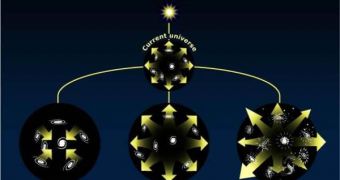In 2003, after unsuccessful attempts at explaining dark energy through other means, a group of astrophysicists proposed the “chameleon” particle model to explain the hypothetical form of energy. Basically, what the model stated at the time was that this class of particles was able to change its mass on its own, depending entirely on its surroundings. Now, a new paper claims to have found the particle in the 2003 model, which was in fact hypothetically constructed to help explain the accelerated expansion of the Universe. According to the research, if the chameleon particle has the ability to change its mass, then it could exert various amounts of force in the things around it. On Earth, it would be too heavy to have any real influence, while in outer space, it could make a difference.
This theory could also help explain why traces of it haven't yet been discovered here on Earth, too. Scientists have over the years hypothesized that photons have the ability to turn into chameleon particles when they pass through powerful magnetic fields. If this turns out to be true, it could have major implications in the field of astronomy, because it would mean that the light reaching us from distant sources is actually a lot dimmer than in reality, after passing near black holes, massive stars, and other objects with large magnetic fields.
For the new investigation, Queen Mary University of London expert Douglas Shaw looked at and compared light coming in from 77 active galaxies around us, using multiple wavelengths. They said that their studies revealed the fact that some of the photons they would have expected to reach us did not, which could mean that they got lost on the way, Nature News reports. “It's absolutely an interesting way of looking for [exotic] particles, and the results are certainly intriguing,” stated Frank Wilczek, particle physicist, Massachusetts Institute of Technology (MIT). However, he cautioned against jumping to conclusions, saying that it was too early.
When they were analyzing the light frequencies, the UK team was aware of the fact that they may have been either witnessing the chameleon model, or the axion one. The latter theory holds that, under some conditions, photons turn into "axion-like" particles. However, only in the chameleon model the photons were required to have the same polarization as the magnetic fields they passed through, which they seemed to have.

 14 DAY TRIAL //
14 DAY TRIAL //